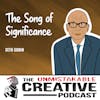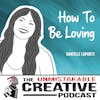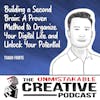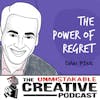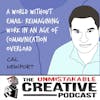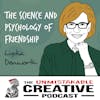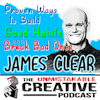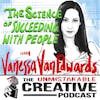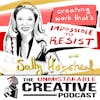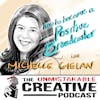Sarah Stein Greenberg | Creative Acts for Curious People
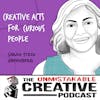
There are more ways to approach any challenge than you can imagine. Sarah Stein Greenberg gives us an entirely new paradigm that, with a little curiosity, could open the door to a more creative and fun-filled world where ideas become action.
There are more ways to approach any challenge than you can imagine. Sarah Stein Greenberg gives us an entirely new paradigm that, with a little curiosity, could open the door to a more creative and fun-filled world where ideas become action.
Subscribe for ad-free interviews and bonus episodes https://plus.acast.com/s/the-unmistakable-creative-podcast.
Hosted on Acast. See acast.com/privacy for more information.
Srini Rao
Sarah, welcome to the Unmistakable Creative. Thanks so much for taking the time to join us.
Sarah Stein Greenberg
Thanks so much, Srini, it's great to be here.
Srini Rao
Yeah, it is my pleasure to have you here. So I found out about your work by way of your publicist. You have a new book out called Create a Back for Curious People, all of which we will get into, which is really kind of very much in line with the content of the show. But before you do that, I wanted to start by asking you who was one of the most influential teachers that you had growing up and what impact did they end up having on the choices you've made throughout your life and career and your own personal decision to go into academia?
Sarah Stein Greenberg
Well, there's a couple that come to mind. I mean, how long do we have? I've had really the good fortune of having some just extraordinary educators in my life. So one who comes to mind is a guy named Will Terry. He was my sixth grade teacher and he was very beloved by many students. And he was a great teacher on many fronts, but one of the things that he did is he always dressed up for Halloween.
Srini Rao
Hehehehe
Sarah Stein Greenberg
And he dressed up to a degree that he was nearly unrecognizable. And he would often do this because normally he had a very generous beard, kind of like a mountain man beard. And often his Halloween costume would involve him completely shaving it off. And so you would walk into class and be just completely disoriented as to who was this stranger at the front of the room, also in costume. And he just had such a kind of sly sense of humor about it.
And I think for me, one of the things that stands out about Will is like, just this willingness to play. Like really, you know, to show up like as a kind of playful adult, even with a group of kids. And I think that has absolutely left an impression and affected me. Another really, really influential teacher for me was
a professor named Paul Dawson, who I studied with in college. And he had a really interesting approach in terms of the in-classroom dynamics. I think I took a class from him on public policy in which something like 70% of the grade was based on your in-person, sort of like your classroom participation. And you really had to speak up.
And I think that was very, very hard for me at first. I was a really shy kid and I kind of, my tendency is to observe a situation first and try to understand it and understand how I can kind of play a role. And the dynamic that he created was one where you were rewarded not necessarily for being brilliant but for taking the risk and speaking up and really getting in the game and participating in the conversation and trying to think out loud a little bit.
And for me, that was a really helpful push and stretch into an area that I wasn't naturally confident in. And it really left a deep impression on me in terms of how do you set the conditions in any kind of learning experience that helps people just stretch into something that's not in their natural, you know, comfort zone or the way in which they think that they already know how to be successful.
Srini Rao
Yeah. Well, two questions come from that. One is about, you know, sort of teaching in general. And the other is about, you know, this playfulness thing. Because you mentioned that you had a teacher who even as an adult could be playful with children. And I feel like one of the things that happens to so many people is that they start to lose that with age. Why do you think that is and how do they get it back?
Sarah Stein Greenberg
No, I don't exactly know why that is. I'm sure that there are some really worthwhile sociology studies or psychological, like a deeper understanding of why that happens. You know, I think there is, like I read a quote somewhere which like, it's not that you get old and stop playing, it's that you stop playing and get old as a result. And I think I believe that at some deep level.
I wonder if it has something to do with, you know, certainly like the expectations that we place on adults in terms of, and just the need, you know, as an adult to be, you know, economically responsible and take care of your family or take care, you know, of a lot of responsibilities. And, you know, a lot of those stressors are real.
But I like to think that being playful can coexist with some of those responsibilities. I mean, that was what I really saw, you know, Will modeling. It wasn't that he didn't then also, you know, care about the quality of our academic work. It was just that he could also express this kind of playfulness. So I just, I don't know. I think that for whatever the reasons that are the factors where we kind of lose that playfulness, which you, you're.
Srini Rao
Mm-hmm.
Sarah Stein Greenberg(08:07.undefined)
we don't see enough in kind of communities of adults. I think it can be recaptured. And I think some of the things that I've learned from being a part of the d.school have really reinforced that for me.
Srini Rao
Now, well, you know, the other thing that really struck me is you mentioned that you have this college professor who basically rewarded you for being willing to take risks. And you teach at, you know, what is one of the most elite institutions in the world where people have been rewarded not for taking risks, but rewarded for success their entire lives. I mean, I know this as a Berkeley student, you know, you're surrounded by, you know, nothing but, you know, people who are valedictorians at their own high schools. And
you know, all of his joke that everybody who was at Berkeley basically got there because they got rejected from Stanford. But you know, when you get people like this in that environment, how do you start to break such powerful social conditioning? Because you know, you come I'm from an Indian family. And the narrative around our house was that, you know, good grades were not something you got rewarded for. They were just what we're expected. And I will tell you, the benefit of that.
is that it leads to a lot of intrinsic motivation. The downside of that, of course, is that you end up tying your self-worth to that and you're always feeling like you're in a competition against the rest of the world.
Sarah Stein Greenberg
Hmm. Yeah, I mean, I see some of that in a number of my students as well. And I think it's, you know, it's just people kind of reacting rationally to the system that they're in. Right. It's like, oh, if that's what you get rewarded for, you know, that's how you start to perform. You know, where I see that mindset being a disadvantage is, you know, when you're like, you may crush any problems that you come across, right, where there's kind of a known answer.
And it's something that you can master based on, a particular approach, a particular formula, a particular operation. And where that really starts to break down is in creative work, where there aren't right answers, there's not one answer. And to get to something interesting and powerful and potentially new or innovative, you have to kind of notice things that people haven't noticed before.
And that includes the faculty, I mean, includes the teaching team. So you have to kind of walk into it, you know, in our case, a design project with this idea that you're going to have, you have permission to kind of look at things in a new way to, to take some of those risks. And I'll say, you know, a lot of students aren't good at that at the beginning. And certainly a lot of the adults who we work with, who are in, you know, leaders in the social sector or educators or, you know, business leaders.
because that has been conditioned out of us to some degree. And what we do to help break down some of that fear or rebuild some of those muscles is a couple of things. So one is, you know, in some cases, classes in some educational environments, like you might sort of tackle one topic at a time and kind of go through a whole sequence. And at the end, you kind of maybe do one project at the end.
So you're learning all the skills along the way, and then you try to put them together at the end. Instead, what we do is we'll often run multiple short projects, kind of building up to ones that are more ambiguous, more open-ended, more complex by the end. But creative work is such an integration process. You're doing a little bit of what we call need finding and research. You're doing a bit of ideation and coming up with solutions and ideas. You're doing a bit of prototyping. You're doing some testing, and you're doing that in an iterative way.
Sarah Stein Greenberg
So it doesn't really make sense to just do one run through that experience. You need actually multiple cycles. That's one thing. And by helping people have some early success, that sense of, oh, I actually can stretch in this way. I can do a little bit more than I realized that I could in this kind of more iterative approach that helps build some confidence that.
you can tackle the richer, more complex, more challenging projects towards the end of a class. And then the other thing I'll say is like, design is full of methods for taking very, very small risks and testing your hunches. And so, for example, one is the idea that, you know, when you build a model or a couple of different models of different ideas that you have for what a solution might be, which we call prototypes,
Srini Rao
Yeah.
Sarah Stein Greenberg
build across a range of directions, essentially. So you can have, you know, one version that's a service and one version that's a digital experience, excuse me, and one that is a, you know, a physical product. And that allows you to test these different hunches in multiple directions before you actually have to like bet on just one. And that's a way of actually admitting, hey, I don't know what the right answer is. There might be lots of different reactions.
Srini Rao
Nah.
Sarah Stein Greenberg
instead of trying to figure out without any new data, which is the right way to go, I'm going to actually get some real response from other people and get that data into my process. So there are lots of methods for actually figuring out how do you start to move more confidently in an environment in which you don't know what the right answer is from the beginning.
Srini Rao
Yeah. Well, so as a follow up to that, I have two sort of final questions before we start getting really deep into the book. I remember when we had Tina here, it seems to be like, you know, for those of you who don't know what I'm referencing, who's in our archive, if you want to listen to that episode. One of the things she said is that she had two types of students who, you know, come into Stanford. She said there are those who come in and they have the entire lives mapped out. They know exactly what they're going to do.
You know, it's like hey, this is my plan. I'm going to med school after this whatever it is And then she said that she has another group who don't have a clue what they want to do And it's usually that latter group that ends up Ironically being more successful Because they remain open to all sorts of possibilities But you know the one thing I wonder just you know based on that and this is something I ask every single Educator that I get the chance to interview is that if you were tasked with Redesigning our education system from the ground up
so that it prepares people for the future of work and doesn't leave them riddled with debt, which clearly is a massive problem in this country, how would you change it?
Sarah Stein Greenberg
I mean, there are many parts of the education system that I think are worthy of redesign. The particular example that you're giving of how do you help perhaps more students, in this example from Tina, I think there's a question there about like, how do you help people kind of find the thing that they is really their life's calling? And how do you help people perhaps not prematurely settle on something?
but leave room for more exploration. And I think, you know, one idea that we've played with at the D school is the idea of like, well, there's actually kind of different modes that you need to be in, in higher education, for example, where they're the phase where you're trying to figure out like, what is it that you actually wanna do? And what do you wanna learn? And what do you wanna study? We have the same kind of design of the system for that part of what college should be about as we do for all of the other parts. So...
You know, we have the same kind of 10 week course rhythm, you know, in a lot of majors, like you kind of got to get started pretty early or you're not gonna be able to finish on time, which also has cost implications. So we have some subtle cues in the system that kind of drive people to, you know, have to sort of prematurely settle on something, perhaps without experiencing as wide a range of different learning modes and types and subjects as they could.
So one idea is like, well, what if you actually had a portion of your education that was really well-designed, purpose-built for that exploration process? Maybe that would look like a whole bunch of two or three week classes. Maybe that would look like something much more experiential. Maybe instead of doing research and group projects more towards the end of your college career, you would do those at the beginning to really try to experience like.
Srini Rao
Yeah.
Sarah Stein Greenberg
What's it like to be a doctor? What's it like to be a biologist? What's it like to actually practice as a designer or as a, you know, in business? So that you have more information when you're then making those kinds of consequential decisions. You know, that's one idea. I think there's also, you know, the reality that, you know, for a lot of people...
Srini Rao
Mm-hmm.
Srini Rao
Nah.
Sarah Stein Greenberg
you know, college or any kind of higher education is incredibly important in terms of their social mobility, in terms of economic mobility. And I think that the reality is like, we sort of have one idea right now about like what good looks like, and we need a lot more ideas, right? We actually need, you know, the range of possibilities for what education could look like.
Srini Rao
Mm-hmm.
Sarah Stein Greenberg
is far wider than what our system actually resembles. And I think could better serve a much wider range of needs. And so I just, I think there's no one right answer. I mean, this is kind of a classic design problem. And, right? And, you know, in terms of what it could look like, but we have very sort of strong norms and assumptions about what education should look like and what good looks like. And I'd love to see, you know, much more
Srini Rao
Hehehehe
Sarah Stein Greenberg
innovation and a much wider range of needs being met through the various systems that we have.
Srini Rao
Yeah, you know, just hearing you say that makes me think of this documentary I saw about the college admissions scandal. And there was a former Stanford admissions officer in the documentary and he talked about how the whole idea of an elite college is basically just an illusion that is created by the number of people that you reject. So it creates this perception. But you know, like I said, I was the beneficiary of, you know, state sponsored education getting to go to a world class institution like Berkeley.
You know, there's no question in my life, you know, that has opened doors and that creates a certain perception. But I think that when I see students today, at least in high school, it just seems that the pressure on them is so immense. I remember one of my friends, Sarah Peck, who also grew up in Palo Alto, said that one of the high schools in Palo Alto had one of the highest suicide rates in the country, which that just seems horrible that, you know, in pursuit of something, you know, noble, you end up with such a tragic consequence.
Sarah Stein Greenberg
I mean, I just, I think anytime we try to fit human beings into, you know, into a checklist or into sort of one pathway towards what success could look like, we're doing a disservice to what that full range of, you know, human achievement, human expression could actually look like.
Srini Rao
Yeah. Well, let's shift gears and get into the book. So what has been your career trajectory that led you to the D school that led to this book?
Sarah Stein Greenberg
Well, I have one of those career paths that I think it makes sense to me in retrospect, but I never could have predicted it. Yeah, that probably you have some selection bias there in terms of who winds up telling you their career path. So, you know, I studied history and politics undergrad, and I was really interested in those areas and art history, too, because I...
Srini Rao
Like everybody I interview. Yeah.
Sarah Stein Greenberg
I just, I really like understanding the why. I really like understanding kind of like, what are the historical factors or forces that have, you know, led to a particular situation or moment, and also making sure to understand that there's, you know, I, there's always many, many different factors going on. I think I'm drawn to those kinds of complex environments and issues. And after college, I worked for,
Planned Parenthood and really was fascinated by the sort of intersection of advocacy and healthcare and education. And then I got interested in trying to understand, what are some of the ways that in the private sector, companies and organizations seem to be really able to kind of change as the market changes a little bit more rapidly perhaps than in the nonprofit world.
And that interest led me to Stanford initially and to the business school there. I had a very non-traditional background in terms of being a business student. So it was like a really eye opening experience for me. I learned an enormous amount. And while I was at the business school on Stanford's campus, the D school got started. It was being founded right at the same time.
So just by pure chance and serendipity, I was able to take some of the very early classes that the D school offered. And immediately just had this feeling that I had found my community. I found my people. This is a group that really is interested in that invisible layer of group dynamics that are so crucial to actually figuring out how do you have.
help creativity emerge in a collaborative environment, in a multidisciplinary environment. And there was a kind of vocabulary being used that I found really helpful because I had some kind of instincts around, some of the things that we do in design, but I just didn't really, I didn't realize that there was a whole professional approach and a more rigorous approach to thinking about, how do you...
Sarah Stein Greenberg
collect subjective data. How do you engage people to really try to understand not just what needs are that exist today, but what might happen in the future and what that could look like. And as I was saying before, as kind of a shy person growing up, like the kinds of, and someone who has a bit of that orientation of like, hey, I'd like to get the answer right the first time. Having some of the methods around, you know,
low resolution prototyping, it's quick, you know, small experiments that, you know, can teach you a lot more than trying to think your way through the problem. Those I found incredibly useful, incredibly freeing in a lot of ways, and allowed me to push my work in directions I could not have anticipated. And after, so after I did a stint at the d.school as a student and then a fellow, and I wound up
working in consulting for a company called Monitor, which is now a part of Deloitte. And at the time, Monitor had just acquired an amazing design strategy firm called Doblin. And so I was lucky enough, again, I mean, there's like, the one theme in my background is just like, being at the right place at the right time.
the sort of integration of the sort of more traditional business strategy, marketing strategy, Acumen that was present at Monitor, and then this design strategy and innovation approach of Doblin, I got to play right at that intersection and worked on a lot of really interesting projects around the world. I spent a couple of years living in India, actually, as a part of that
Srini Rao
Yeah.
Sarah Stein Greenberg
to the states and in 2010 moved back to California and returned to the D school, then as the managing director and then a few years later as the executive director where I have been since then.
Srini Rao
Wow. So I'd love to ask this from a sort of design perspective. One of the things that you mentioned was that you sort of found your people. And I realized so often when we go into the working world, at least for me as the guy who was fired from every single job I had, there's a question that never seems to come up when people get put on performance and proven plans, and that is whether you're actually in the right job to begin with. So how can you use the principles of design?
from a company perspective when it comes to hiring to increase match quality in terms of the right people doing the right jobs.
Sarah Stein Greenberg
You know, I, one thing that question reminds me of is I believe that there was a policy at Zappos, um, at least in the early days of the company that I was really, really excited by. And the policy was that when you were hired, you were automatically in kind of a, um, not probationary period, but sort of a conditional period. And I can't remember if it was.
It was a couple of weeks or a month or two weeks, but it was a defined period of time. And at the end, there was a moment where both the company and the employee kind of got to say, hey, this is working or it's not working. And there was kind of a kind of no fault way for everybody to walk away from that hire. And I remember being so impressed by that because it just struck me as like,
Srini Rao
Yeah.
Sarah Stein Greenberg
that allows you without kind of in a way that's not about trying to make a bad situation incrementally better if somebody you know it's like if that's not the right job for you or the you know somebody made a mistake essentially really just to try it out and there was like a whole policy and a whole culture built around that and I would so impressed because one it I just can only imagine that if you if everybody did decide it was the right fit like wow I can only imagine the effect on
Srini Rao
Mm-hmm.
Sarah Stein Greenberg
and sort of satisfaction being much higher after that kind of test period. And what strikes me about it is like, what they had to do is like, design the stigma of it not working out, out of the situation. Because I think that's where both companies and individuals would get into troubles. Like when you make a mistake and you land yourself in a job that's really not right for you, or the company that's made a mistake, it's like, well, you know.
Srini Rao
Yeah.
Sarah Stein Greenberg
that does not feel good to walk away from and for anybody. And so if there's a way to reduce the stigma of that, of making that mistake, I just feel like that could be much more freeing. So I don't know if that's the right answer for every situation, but I love the kind of design principles that work behind that strategy.
Srini Rao
Yeah.
Srini Rao
Yeah, I think that, you know, I sort of came to this realization when my sister was in medical school and I realized, oh, you're doing all these different rotations to figure out what area of medicine you actually want to go into. And typically when you get hired for a job, you get hired to do one job without the opportunity to explore within that company. I mean, I know there are certain companies that have rotational programs for undergrads, but I feel like so often we're kind of just pigeonholed.
Sarah Stein Greenberg
I think that's right. And I feel similarly about college, as I was saying. Like, I think it would be really interesting to figure out how to use more of that rotational model earlier in a student's career in a more powerful way.
Srini Rao
Yeah.
Srini Rao
Well, so there's really no way that we're going to be able to cover every single exercise in this book in this bit of an hour, because there's so many of them. So I wanted to go into a few of them that really struck me. Let's start with observation. One of the things you say is that learning to observe and register feelings in others is crucial in widening your lens because it helps you connect to how the world might appear through others eyes and kindles your imagination for what you could create.
Learning to appreciate the feelings of teammates without conflicting viewpoints and to collaborate in an open and vulnerable way is the key to creative teamwork. And what I wonder is for people who are listening, many of who are creators on the internet, how do you apply that in the case where you're not necessarily getting to have a face-to-face or even verbal interaction like you and I are having where you're hearing somebody but you're just communicating with them digitally?
Sarah Stein Greenberg
Well, I guess I'll say, just to frame it a little bit, I think in general, in any kind of creative work, registering and understanding the role that emotions play is really important. It's important even if you're completely working on your own and what you're realizing is that like, wow, there are highs and lows in any project. And like, how do I deal with that? How do I recognize that? How does that affect my work? Do I...
need help at certain stages? Do I need to reach out at certain stages? So like emotions just are a feature, not a bug in any kind of creative work. And I think that is particularly true than when you're working with others. It's like that is only magnified, it's only intensified because everybody's having emotions all across the team. And I will say like the conversation that we're having, audio only, like.
we can get to a level of understanding and connection. It's not about being face to face or perhaps not even about being in proximity, but it is about making the space and the time to hear somebody out, to like pause and let somebody continue their thought and maybe expand on what they were thinking. I think that there is a lot about, you know, just purely written.
or purely digital interactions where some of that gets a little bit cut off. And I think if you want to have a real creative bond with somebody, you do have to make the space for that. Just make a little bit of time for that. One incredible assignment from the book created by an instructor at the D school named Glenn Fajardo.
it actually really assumes that two people are going to be working at a great distance, perhaps across cultures, and perhaps without even sharing a primary language. And so in this assignment, it's a way to actually build a deeper connection with someone just visually. So the way it works is that you each take photos of your daily life for a period of a day. And then on the second day, you have a 20-minute window where you have a conversation just by sending photos back and forth.
Sarah Stein Greenberg
But the key is that you're not just randomly sending photos. You respond, you try to relate to the photo that you've just received from the other person, like no words, no emojis. And you're trying to, essentially you're having a wordless conversation. And the goal there is to establish a relationship where you understand a little bit more about the other person. So I don't think it's impossible in a digital environment. I think it's much more about
Srini Rao
Mm-hmm.
Sarah Stein Greenberg
Are you creating those opportunities for connection to emerge? Do you understand the value of those? Do they help fuel you? Do they help build that more trusting relationship with someone else?
Srini Rao
Yeah, it's funny you say that because it reminds me of the situation I had. I was seeing the scroll long distance and we had this joint playlist on Spotify. And there were certain days where we didn't want to talk on the phone because I don't really enjoy talking on the phone for hours on end. So we would just listen and each person would pick one song and we were effectively having a conversation through our music choices.
Sarah Stein Greenberg
I love that. That would be really a cool build on that same assignment. It's like you could do the photos and then you could add a playlist.
Srini Rao
Yeah. Let's talk about another thing that struck me. And the reason this struck me was because this is something I see from almost every one of my readers. It's something that every creative person wrestles with. You say that producing creative work, actually getting it out of your head and onto the page or into the world requires you to deliberately suspend your evaluative brain at specific moments. You want to temporarily defer judgment on what might work in order to explore a new concept without prematurely dismissing it as impractical.
or unfeasible and then you go on to say that judgment is incredibly important. You need to survive and to course correct your way through life. But the ability to put your critique on hold is what allows you to sometimes pursue a wild idea. You wrote a book so you know this better than anybody. That is really, really hard for a lot of creative people to do. It took me a long time to get my head around that. And I always say, you know, I am an average writer who writes a lot and that's the only reason I write anything worth reading.
Sarah Stein Greenberg
Yeah, so you go for volume, it sounds like, which is a major insight about your own creative process that I think everybody needs from time to time. I mean, I struggle with my own inner critic for sure. And she came out loud and clear at many moments during my writing process. Actually, I had to develop kind of some new, I was, a book is such a...
you know, long-term project, like I had to develop some new ways of dealing with her because she can be very loud and very bossy in my head at times. So I definitely, I think, you know, the practice of being able to suspend judgment is something you are constantly working on, like no matter how much creative work you have produced in the world. And everybody does it a little bit differently.
Srini Rao
Yeah.
Sarah Stein Greenberg
I think it is just so powerful, even just to really understand that when you can get into that, maybe it's the flow state, maybe people have different ways of describing it, but when you can suspend judgment, it does help you increase your output, increase the volume, increase the range of ideas you might be exploring. And then you also, I mean, the complement to that is then you do need to go back and say, hey, what of this is worth keeping or publishing? Or
Srini Rao
Yeah
Sarah Stein Greenberg
You know, like you do, it's like, you can't, they don't work without each other. It's really, they're really complimentary modes. And, you know, there are different ways that people found for doing that. I think one student team that I recall, like literally made a sign about whether they were trying to, you know, be in a mode of diverging or converging.
in terms of like, were they trying to like come up with lots of options or explore without being judgmental, or were they in a decision making and evaluative mode. And they would literally like flip that sign around when they were, you know, deciding as a group to switch into the other posture. And that just physical prop like helped them be much more mindful and kind of create that social norm within their group, so that they stopped, you know, blocking each other.
And Dan Klein, who's one of the contributors to the book, who teaches in the theater department at Stanford, he made the comment to me that, you know, like a lot of team conflict really comes from when one person is exploring. Just implicitly, they're kind of in, they're trying to like, you know, think through something, they're sort of in a more open-ended posture. And the other person is like trying to get to a decision or, you know, trying to kind of move on. And that is where a lot of conflict actually stems from.
So having that vocabulary, having that ability, just by yourself to understand, ooh, am I slipping into a more critical mode? Is that the right moment for that? Those are, I think, incredibly powerful ideas and practices to develop.
Srini Rao
Yeah, absolutely. Yeah, I mean, I love that you brought this up because I even remember reading, you know, in Seth Godin's book, The Practice, that he talks about, you know, feeling like an imposter and you're thinking, you feel like an imposter, you wrote 17 New York Times bestselling books. So if Seth feels like that, then it's no surprise that all of us do. Let's talk about this whole idea of talking to strangers. As somebody who pretty much does this for a living, it probably was one of my favorite parts of the entire book of all the things I saw.
Sarah Stein Greenberg
Ha ha ha ha ha ha ha ha ha ha ha ha ha ha ha ha ha ha ha ha ha ha ha ha ha ha ha ha ha ha ha ha ha ha ha ha ha ha ha ha ha ha ha ha ha ha ha ha ha ha ha ha ha ha ha ha ha ha ha ha ha ha ha ha ha ha ha ha ha ha ha ha ha ha ha ha ha ha ha ha ha ha ha ha ha ha ha ha ha ha ha ha ha ha ha ha ha ha ha ha ha ha ha ha ha ha ha ha ha ha ha ha ha ha ha ha ha ha ha ha ha ha ha ha ha ha ha ha ha ha ha ha ha ha ha ha ha ha ha ha ha ha ha ha ha ha ha ha ha ha ha ha ha ha ha ha ha ha ha ha ha ha ha ha ha ha ha ha ha ha ha ha ha ha ha ha ha ha ha ha ha ha ha ha ha ha ha ha ha ha ha ha ha ha ha ha ha ha ha ha ha ha ha ha ha ha ha ha ha ha ha ha ha ha ha ha ha ha ha ha ha ha ha
Yeah.
Srini Rao
You say that I have large opinions about small talk, its prescribed blandness confines our first interactions with new people to safe categories of interest we're all supposed to have in common, sometimes it breaks down along stereotypical gender lines, sports are supposedly for men, clothes for women, weather for everyone, in my mind small talk is just about the cruelest way that people have found to bore each other while providing reassurance that we're not a threat to social order.
Despite our social norms for engaging strangers for the first time, I found it remarkable what people will share with each other after a relatively short period, if you take care to set the conditions well. This bonding lies at the heart of launching effective and open-hearted collaboration. And I think the reason that struck me so much was because it literally described why I choose the questions that I do to start my interviews.
Sarah Stein Greenberg
That's very interesting. I mean, it sounds like we have that in common in terms of like, I'm so curious about people, but I wanna get to the real stuff as quickly as possible. And, you know, like, you know, of course I understand, you know, the role that small talk plays in terms of like helping people kind of enter a conversation and kind of a safe way. But in the context of...
Srini Rao
Yeah
Sarah Stein Greenberg
you know, doing creative work, working on a design team, you've got to get past that as quickly as possible. And so there are a lot of ways that we use at the d.school to build some of those bonds as rapidly as we can. And the reason that's important is because if you don't actually know something authentic and real about the people that you're working with and they don't know you.
there's a lot of guesswork and a lot of playing it safe about like not really expressing your most, you know, wild idea or your riskiest thing, or, or when you're feeling, um, nervous or frustrated or you're, you know, really stuck on like, how do we frame this problem? How do we build this prototype? Like you have to have some of that, um, just actual like human, you know, bond with somebody to help them navigate through, you know, difficult work and vice versa.
And so it holds teams back if they stay in that sort of very superficial layer of small talk. So, you know, one of my favorite, and I put this in the book, my personal favorite kind of sequence of helping people get past that small talk barrier. You start with pairs, you know, if you're at a workshop, you're in a class, you're at a conference.
and you have the pairs of people kind of meet each other and tell each other the story of their name. And that could be, it's a very open-ended prompt, right? It's like, you could tell me about your parents and your culture, and I could tell you about, you know, why I have two last names and not one last name, and, you know, or something completely different. And then you progress to a little bit of a deeper question, and you, in the case of this particular sequence, then you, each pair gets a...
Srini Rao
Yeah.
Srini Rao
Mm-hmm.
Sarah Stein Greenberg
with another pair and they, you know, there's a prompt about sort of what skills do you bring in the event of a zombie apocalypse. And that's great because it allows people to get outside of their normal professional way of describing themselves. But it's also very safe. It's like, oh, I can bake bread or I'm a good mediator. I've heard that come out. Somebody told me they were like really good at building community under times of stress. And I was like, wow, that is going to be an important skill in the zombie apocalypse.
Srini Rao
Hahaha
Srini Rao
Yeah.
Srini Rao
Absolutely.
Sarah Stein Greenberg
And then the last stage is you ask people to really talk about like how they're seen and how they're known and how they want to be known. And that just goes deep. Like that really is a powerful way of asking people who've started to connect with each other a little bit to think about how do you want to show up in this collaboration? How do you want to do the work that we're going to do together? And kind of going back to where we started in terms of the theme around play, you know, this is a playful.
Srini Rao
Yeah.
Sarah Stein Greenberg
experience, but it's about getting people ready to do quite serious work oftentimes, whether it's serious because creativity does have those ups and downs and you gotta show up for each other during that time, or because you're tackling some kind of project that has, you know, potentially has real consequences that could really help people, or could be trying to, you know, address some kind of, you know, medical need or, you know, legal need, some kind of really impactful work. So...
I think for me, there's a really interesting balance around these ways of bringing people into that very serious work, but not abandoning our ability to play and to be real with each other and to really connect.
Srini Rao
Yeah, you know, it's funny because Vanessa van Edwards who was a guest here actually said, you know There are two sort of ways you can start a question Yeah a conversation and she said, you know that if you know start a conversation with the typical questions of what do you do? Where are you from? she said people have default answers to those questions and so it doesn't end up becoming engaging and That's often why you know, I will jokingly, you know pretty much go for the juggler We've had guests here or relationship experts and I'll say okay Tell me about the first time you got your heart broken to start the interview
And it's amazing what people will tell you.
Sarah Stein Greenberg
Ha ha ha.
Sarah Stein Greenberg
I think that's right. I think people generally want to connect. And if you create a safe environment, you can get to those more meaningful conversations. One of our pairs of instructors, also contributors to the book, Michael Berry and Michelle Zhu talk about
Sarah Stein Greenberg
really thinking about holding space when you're interviewing someone, you're really trying to hold the space for them. And that creates this sort of ability for people to kind of reflect on their own beliefs and to share some of their stories with you. And there are lots of ways that you need to uphold that safety and create those conditions for folks to be, to feel that genuineness, your genuine interest, your genuine curiosity, your respect.
and understanding kind of what your goals and intentions are. So I think there's, you can get people to really open up if you establish some trust and you show that you're trustworthy.
Srini Rao
Yeah, I mean, I think that that's one thing that I wrote this entire guide on conducting interview. And I said, you know, you can ask really deep, even deeply personal questions, as long as it's done with, you know, positive intent. You know, not like
journalists who, you know, drill people to write sensationalist stories, but really to paint this person a positive light. And that's always, you know, one thing I aim for with everybody. So one thing that really struck me, I think it's because of the sheer volume of information that I'm exposed to as a byproduct of, you know, the number of people I interview and the number of books I read is what you said. You say that your brain is constantly making shortcuts to help you process the immense amount of information perceived by your eyes, ears, and other senses.
interprets other things. It's just trying to give you the most helpful information at the right time, which makes a difference if you're hungry or scared. This helps you move through the world efficiently, but the efficiency comes at a cost. You develop habits and get stuck in ruts of thinking and noticing. Your beliefs, your previous experiences, your pace, and even your cognitive load at the moment all affect what gets through the filter and conclusions you draw as a result.
And so I wonder how you prevent that from happening because I know that all of us have cognitive biases And of course, they're all unconscious. So we're not even aware of them
Sarah Stein Greenberg
Yeah, I mean, I think it's really, really useful to like, you know, challenge some of those patterns and some of those habits. And one assignment that I love to share with people is called the derieve. And this is, I mean, it's about exactly what, what you're describing. It's like, you need to retrain your attention at various times. So you can start to see the things that you've been missing.
And with the derieve, you take a walk around your city, around your neighborhood, wherever you happen to be, around a shopping mall, and you choose a quality of something to follow. And this actually, this method comes out of a kind of art and political movement in France in the 60s and 70s called the Situationist Movement. And it's a way to drift. And instead of having like an agenda, you allow yourself to follow a quality like the color yellow.
or a certain type of a line. I've had people follow like squares or sounds. And the interesting thing is that, so you walk to that first thing that's yellow and you kind of investigate it a little bit. Maybe you make some notes about it and draw a little map. Then you move on to the next thing that you see that's yellow and then the next thing. And there's something really intense that happens when you're allowing yourself to,
to move around a space in this very unusual way in terms of not having a preordained path, but allowing yourself to find the next stop along the way. And you see things that you may have walked by for years and that you have absolutely never noticed. And so just having some of those really, I mean, literally eye-opening experiences can first start to say, okay, I really am missing a lot of what's out there.
Like, okay, well, what else am I missing? Am I missing a lot of opportunities, in the data that I'm looking at for making important decisions at work? Am I missing important social cues? Am I fully registering and understanding the emotions and the needs of my teammates? And so I think it can be helpful just to start to raise some of those questions in kind of a self-awareness kind of way. There's another wonderful
Sarah Stein Greenberg
assignment that comes that Scott Dorley likes to teach. He's our creative director at the d school, which is just called a seeing exercise. And you take a photograph, and you observe and kind of name what you think is happening in that photograph. And then you say why you think that's the case. And then you talk about why you think that's the case. And it's a process of noticing small details. And one recognizing that like,
without engaging with the people in that scene, you actually don't know for sure. So you're completely in the space of hypothesis and hunch, but it's like the longer you look at a photo, the more that you notice. And I think, again, that's a very useful way of recognizing how much information we're actually constantly filtering out and skipping, and that when you sit down and actually with a very mindful approach, kind of train your attention in a new way, there is so much more out there to observe.
Srini Rao
Yeah. Let's get into one more idea that really struck me. You say that to come up with novel, compelling concepts that helps to build on the ideas of others, an idea that's bouncing around between two or more brains might just be cooler, weirder, or more insightful. All good things that you put in the position to consider a wide range of potential solutions, this process requires you to listen and then respond, as opposed to just generating new ideas internally and then saying them out loud. And I think the reason this struck me
Pretty much every single thing that I write is inspired either by a conversation I've had with somebody like you or something in a book that I've read. But there's this interesting balancing act between what I call mimicry and modeling. So how do you use other people's ideas but avoid mimicry?
Sarah Stein Greenberg
Well, I think, I mean, you know, sort of being able to be honest about where that inspiration came from, I think is actually really important. And, you know, I tried something in this book that I hope, I hope lands really well, which is that, you know, a lot of like, you know, a lot of the writing in the book that's, you know, completely coming from me. But a lot of the underlying ideas, they come from the assignments that other faculty and instructors at the D school have taught.
And I wanted to make it really clear that these concepts, these ideas, these practices are originating from a very wide variety of people, which I think makes the book way more interesting and useful to readers. It's like, you know, 100 brains are involved in this. And so I really tried to track down and to acknowledge the, you know, sort of the origins of
of a lot of these different practices. I'm sure I didn't get every single one perfectly right because as you're saying, a lot of methods that we use, they come from, and have been adapted and built on this long history in design or in art or in other kinds of creative practices. And I think where the balance comes for me is, is this being adapted and...
shared in the right context? Is it relevant for the moment? Is it about stretching it into a new sector or a new type of problem that you're trying to figure out in a way that perhaps it hasn't been before? Are you trying to introduce it to folks? You know, it's like these are practices that designers use intuitively. At the d.school, a lot of what we're trying to do is to bring folks who have, you know, completely different disciplinary backgrounds into the fold and into
a space where they can apply their own particular expertise, but come together in a creative process. And so, like, for me, a lot of that balance comes from, you know, introducing these ideas to new audiences in new ways, in, you know, like in the current moment that we're in, and thinking about how do the tools need to evolve, how do these things need to shift and to change. So that's kind of where I find that particular balance.
Srini Rao
Yeah.
Srini Rao
Yeah, I think that really struck me because I was jokingly say I don't really know anything. I'm just the accumulation of a thousand other people's ideas, many who are smarter than I am and better at what they do.
Sarah Stein Greenberg
Well, I think there's real value in the way that you're able to, you or other folks who are like, I absolutely can't comment on whether you're originating ideas, which you probably are, or you're recombining them, or you're sharing the ideas of others. But that is also the storytelling, the way in which people are then able to relate to
the ideas is a tremendously valuable service. So I think there's, you know, we have a little bit of a hang up, I think, or maybe it's even a myth in many kinds of creative work that like, if it's not brand new to the world, somehow it's not valid or valuable. And I just actually don't think that's how creativity works. I think that we have some like storytelling that that's how creative, that's you know, how what creative work looks like. It's kind of similar to our conversation about like,
success looks like one particular way in an educational environment. We design our whole educational environment around that. Well, I guess part of what we're trying to do at the d.school is really say like, creative work is a team effort, right? To actually get to really powerful complex solutions in problems that are important and serious, like you need lots of people coming from lots of different perspectives to contribute.
that is very different than that model of sort of the individual creative superstar. So I kind of like to see that myth go away a little bit.
Srini Rao
Yeah. Well, so let's finish with two final questions and one last concept. You talk about this idea of what you called bi-association, and you talk where you say, while writing about creativity in the mid-20th century, Arthur Kessler, whose book, The Art of Creation, inspired the assignment coined this term, and it combines ideation coming up with new ideas with synthesis, connecting to previously unrelated things.
and the activity is a good way to help train your brain to challenge regular boundaries between apparently incompatible frames of reference, which helps you come up with bolder, more novel ideas. So how do you actually do that?
Sarah Stein Greenberg
So I learned this practice from Hannah Jones, who's a former fellow and a teacher at the D school. And she, the way that she runs and has designed this assignment, you essentially, like if you're in the middle of a brainstorm or any kind of ideation session, let's say you're doing it with a team, you would take all of the ideas that you've come up with, you write them on individual cards or sticky notes, and then you get into pairs and you each have a small stack.
And each of you takes the first on the pile and you put those two ideas together. Now they're probably two completely unrelated ideas. And you have to come up with a third idea that somehow builds off of those original two ideas and that's your bisociation. And at the end of your, you've got your sort of the new ideas that have come out, you perhaps even try to come up with a super bisociation. Like try it, can you get one idea that connects all of those new ideas together?
And one of the ways that this activity can function is like, it introduces some randomness into a process, which is extremely freeing. And you're also like, you're not actually going for good ideas at this moment. You're really trying to push in terms of that sort of like more playful kind of just out there concepts. And actually the experience of allowing yourself the freedom to not work on good ideas.
but to work on interesting ideas or novel ideas that are becoming, you know, are coming to be because they have to connect, you know, a bicycle and a moose, right? Or, you know, whatever the two, you know, strange things that come together are. That is, that's like the, giving yourself an embodied experience of what it feels like when you come up with that more novel, more interesting idea.
And that can be profoundly useful, again, as a way to sort of like retrain your brain for a moment. And it's also good to just like have that moment of play with a group. And you can certainly do this on your own just by like randomly, you know, mixing a set of cards and then trying to come up with those, you know, by associations yourself. But I think that, you know, there's a, an underlying theme in a lot of our practices, which has to do with
Sarah Stein Greenberg
Can I have an embodied experience of the creative behavior that I'm seeking to develop, the skill that I'm seeking to develop in a fun way, in a quick way, so that then when I'm approaching that same kind of task in a longer term effort, in a serious design project, you've had that experience already, you have a sensitivity to what that skill needs to look like.
Srini Rao
Amazing. Well, this has been really, really insightful and thought-provoking. So I have one last question for you, which is how we finish all of our interviews at the Unmistakable Creative. What do you think it is that makes somebody or something unmistakable?
Sarah Stein Greenberg
I think it's that quality of self of like being, you know, who you actually are and sharing that a little bit. I think, you know, I guess I tend to remember and gravitate towards people or experiences or, you know, movies or, you know, any kind of work of art that just feels...
I guess the word is authentic, but I'm struggling to try to find a kind of less sort of the moment word. It just feels real. And I think that's a rare quality. It requires a lot of vulnerability and disclosure. And yeah, I think that's really the first thing that comes to mind when I think about what makes something unmistakable.
Srini Rao
Amazing. Well, I can't thank you enough for taking the time to join us and share your insights and stories and wisdom with our listeners. Where can people find out more about you, your work, and the book?
Sarah Stein Greenberg
Well, thank you.
Sarah Stein Greenberg
Yeah, well, thank you so much for having me. This was a really fun conversation. You can find out more about me at the d.school website, which is dschool.stanford.edu. We're actually in the midst of publishing a whole series of books. So there's Creative Acts for Curious People, which is the one that I have just brought into the world, but then we have some really cool books coming up around navigating ambiguity, around designing with data around courage and around designing for belonging. And those you can find at dschoolbooks.com.
Srini Rao
Awesome. And for everybody listening, we will wrap the show with that.
Candid Conversations: Elevate Your Thinking with Masters of Their Craft
Dive into a realm of transformative conversations, where wisdom from trailblazers who've shattered norms is at your fingertips. Learn from best-selling authors who've decoded productivity, and thought leaders who've sculpted the landscape of personal and professional growth. Unearth the secrets of successful entrepreneurs, delve into the science of habits, and explore the art of charisma. Each conversation is a journey, brimming with unexpected insights and practical wisdom that will ignite you
